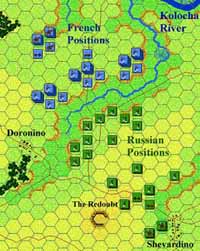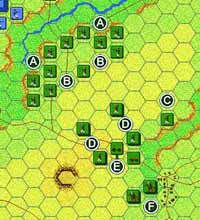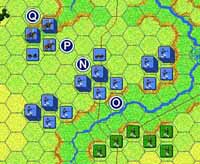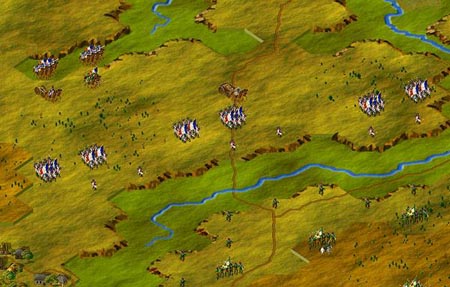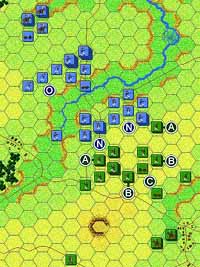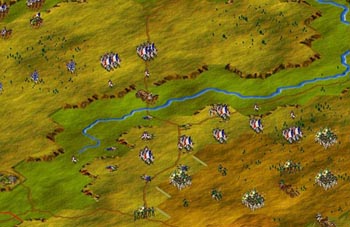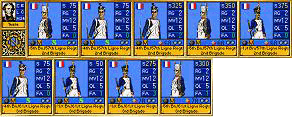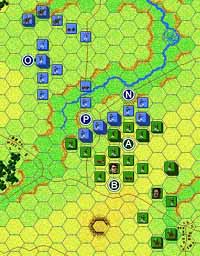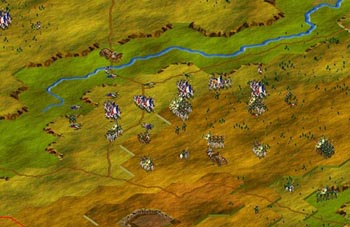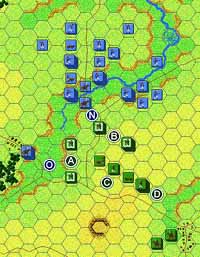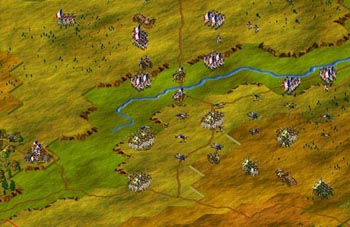|
Allied Training College (ATC) Coalition Library |
Russian Infantry Tactics [Written by Jason Cawley and Published as part of the Cawley Papers] |
Part I: A Companion Essay for the Shevardino Scenario of Napoleon in Russia Using the 27th Division of VIII Corps, 2nd Army of the West on the map of Shevardino, a combat at the Battle of Borodino, this document illustrates the principles discussed in the Russian infantry tactics article Squared Away - The Russian Division. Further items from some of the other articles in the series are mentioned as well. Opening Positions The opening scene (12 Noon, French to move) shows an initial deployment of the division for defense of a limited frontage. Assume there are other units more or less covering the flanks but facing other French forces.
Russian Position The Russian 27th Division is in position in a standard Russian defensive formation on the hill northwest of Shevardino Village. The main body of the division is in its characteristic box shape, screened in front by its light infantry brigade and supported behind by a brigade of Dragoons.
Along the line of the gulley is the skirmish line of Russian Jagers (A), with their supports in line formation 1-2 hexes behind them, backing them up with a line of ZOCs (B). The 4th battalion of Jagers is held back in reserve at first, in column to the right rear (C). Three hexes behind the Jager supports is the characteristic 'box' of the Russian infantry division line troops, in 4 regimental columns (D). Notice that the Russian regiments range from 700 to 1175 men, and with 1/2 column firepower have the line-equivalent firepower of 350-587 men. The formations are effectively 6 ranks deep, each. 1st Brigade is on the left, 2nd on the right. At the center and rear of the box is the divisional light battery (attached in this case) (E), and behind it the supply wagon. Behind the 27th Division, on the notional 'support line', a brigade of Dragoons is in support (F). In a typical combat situation, the cavalry might have to support several formations, but its relative position is correct - the cavalry is close enough to reach the forward edge of the position with a move plus charge phase, but otherwise stays out of artillery range and LOS as much as possible.
French Position The French are drawn up to fight in column formations, with 3 brigades of Compans 5th Division of I Corps shown. They are deployed tightly at first but ready to move out; they would fight on this limited frontage in two up, one supporting fashion. Behind them is a Cuirassier Division, St. Germain's.
Each brigade is in side-by-side column stacks (N), screened by two of the skirmish companies (O). The stacks are 800-1150 men, with line-equivalent firepower ranging from to 383-433 men. They thus represent formations 6 to 8 ranks deep. (The columns are 9, the skirmishers 3, so the mix is between the two). The melee and fire ability of these stacks are thus comparable to those of the Russian regimental columns. They will also illustrate other formation in the course of this series of files, but for now they set to fight in column. The Cuirassiers behind them are organized with Light-Horse in front for scouting and covering (P), then the heavies in two brigades side by side (Q), supported by the third behind both. French artillery is scarce, although in the real Shevardino fight it is rather the artillery ammo that is the issue.
|
||||||
Part II: French Attack and Russian Response The French Advance The French advance across the gulley, and at first try to push up the slope in economical fashion, with only a few columns meleeing the Russian outpost line. In the course of that, each side loses about 100 men and a few of the Russian Jagers are disordered. The move leaves a few French columns punching into the Russian formation, and how to deal with these is the first decision the Russian commander faces. He can choose to send forth his formed infantry at once, to retire the Jagers to form a new delaying line, or if the penetrations are small he can try to pinch them off 'locally', using just the Jagers. This last is what was attempted here, and almost worked. But one French battalion put in a fine performance and at the end of the Russian turn the Jager position was therefore somewhat distressed. The French seized this chance and push ahead aggressively, meleeing across the front with the bulk of the two forward brigades (N). Naturally, this seriously manhandled the Jagers, and losses to this point favored the French. They got up out of the gully and seemed to have done well - but the aftermath of their push was that they were in some disorder, units jumbled together as well in 'contagion' distance, not all with leaders, and occasional units were fatigued or low on ammo. Thus, morale throughout this mass of men was down to 3 in many places, with occasional 2s in the crowd.
Russian Response This is the moment at which the Russian infantry advances to contact. Just the forward regiments of each brigade do so (A), leaving 2 regiments still in second-line (B). The battery moves up to cover the crest-line at caseshot range (C), but as yet no French are above it so it plays little role yet. The Jagers withdraw through the advancing division. The Russian forward regiments deliver their attacks on two chosen points in the French 'crowd front'. They only fire; melee would be resorted to it the strengths allowed and fire failed. But in this case, they got hits and did not need to press into melee. In the ensuing French command phase, one of the units hit routed and carried away three of its neighbors (O), also spreading disorder widely and preventing quick recovery from that already existing from the fight with the Jagers.
Analysis A glance at the victory and 'strength' screens tells the tale. The Russians have lost more men because of the mishap with the Jagers (or from their decision to chance delaying the move up). But the French, after their rally phase, are only 63% in good order to the Russians 94%. Moreover, of the two French attacking brigades, those figures are 0% (the 25th Line, half routed and the rest disordered) and 61% (the 61st Line, 2 battalions and 2 skirmishers disordered). Also notice how poorly the French infantry could handle cavalry at this moment - only 2 hexes could form square. They are in fact quite vunerable. Because of this, they need to reorganize. They will pull the half-routed 25th Line out of the fray altogether, sending up the reserve brigade to replace them, while reorganizing the 61st Line in place to try to keep the ground gained. It is true the Russian Jagers have been decimated, other than their reserve battalion, but after some rally and reorganization will be able to muster 8-9 skirmishers and 3 small formed units to perform their screening role again, or if fully broken down would still provide 16 skirmishers to the division. This reduction is the natural cost for waiting too long to advance to the Jager's relief.
|
Part III: Relief, Reorganization and A New Attack Relief and Reorganization This shows the French relief and reorganization, the Russian response, and the French moving to attack the resulting Russian position. The Jagers pull back and continue to reorganize, trying to get into columns and to stack (A). Their reserve battalion's companies, however, and a few good-order companies, are available to help support or plug the main infantry lines. French offensive fire disordered one battalion of the Odessa Infantry, which was forward on the right side of the Russian position. So, it pulls back to reform (B), while its second line, the Tarnapol Infantry, takes its place stopping the French 61st Line (C). Meanwhile, to deal with the French reserve brigade advancing in good order, the Russians decide to rely on a favorite Russian tactic, for which their regimental column tactics and their whole army organization, are particularly suited. Both regiments of the 1st Brigade advance to the line, holding two 'shoulders', ahead of the French 57th Line (D, E). Their depth is great enough that moving them in melee is not easy or cheap in fatigue terms. Between these held shoulders, just behind the line, the Russian's light battery wheels into position, bearing between the two Russian infantry regiments and directly on the formation their presence has halted and fixed in place (F). The state of the ground here requires that to be done at two hex range to have line of sight. This is a little closer than is ideal - 3-4 hexes is best. That allows for one lost melee without needing to move the battery, and also avoids the occasional gun-crew loss to long range infantry fire. But tactics must adapt to the local terrain, and this will serve.
The French Attack The French decide to risk a 'press' of men, to try to storm the ridge-line and dislodge the Russians by weight of numbers. The 61st Line is on their left, and adopts a tight 'ordre mixte' formation. In the first hex, 2 battalions in column with 2 skirmish companies - in the center of the regiment 1 battalion in line formation (N) - then in the last hex, again 2 battalions in column formation with 2 skirmish companies. This puts slightly more than half the men 'on line' or represents a depth of 5-6 men across the frontage on average, but deeper on the column-anchored flanks. In BG terms, ~1000 of the men contribute firepower. Beside the 61st, the 57th continues to fight in its column formation, only 2 hexes across for this 'press' (O). At the juncture of the two regiments will be the decision, as 5 battalions attempt to move the Vilna Infantry (which, just coincidentally, is my own unit in the Club). Only if this key melee succeeds, will the flanking units push back the Russian skirmishers on either side. The French hold their fire to boost their chances since the ridge is against them, while the Russians, with the ridge line to help, fire instead and thin the ranks of the attackers somewhat.
Analysis Needless to relate, the attack fails (hey, this is my unit, didn't I tell you?), winding up as a 3:2 +1 attempt and resulting in 50 Russian to 100 French casualties. Notice, further, how expensive this sort of attempt can be, as the French took 15 total fatigue to battalion units, on top of the couple inflicted by Russian defensive fire, while the Russians took only 4. Furthermore, consider the situation of the French infantry even on a success. The Russian light battery can rotate right and bear on the attackers from caseshot range, flank, at a column target. Even with the movement that is a great shot. The target would be disordered and fatigued and hit in flank; even led and good troops targeted, the chances of rout are thus quite high. And a rout would carry away half the men in the hex. Disordered after the attack, as some of the flank units are just because of Russian fire as well, the whole mass would also make an appetizing target for Russian Dragoons. They certainly could not make it into square. Indeed, they are a fine target for a charge now, but the Russians refrain and rely on the infantry instead.
|
Part IV: Russians Reorganize and French Disordered The Russians Reorganize The Russians relieve the disordered half of the Vilna Infantry with the entire Odessa Infantry (A), now reordered after its brief spell out of the line. The 1st of the Vilna, though, remains in line to bolster this key location. Single battalions were disordered by French fire on the flanks; they pull back to reorganize. As there is no addition relief regiment available, they leave their good-order battalions in the first line. When lower in strength (on the right in this case) these single-battalion positions can be supplimented by 1-3 Jager companies, which also help boost their firepower to more like the level of a regiment. The second line of the division is now a more disorganized place (B), as single battalions in disorder come back to reform. But the division has handled the assault of 3 French brigades, disordering majorities of all three. The French infantry has taken 46 fatigues, not counting skirmishers, and roughly 1/4 of the battalions are in a yellow fatigue state,with 1 already in red. And the entire front line of the Russian formation is still in good order, pretty much smack on the line the Jager supports originally occupied. Because of that order, and with the battery now in position and bearing on columns are range 2, the firepower of the Russian division is quite formidable for its frontage. The Jagers contribute about 25 expected hits a phase; the formed infantry 75, and the battery more like 100 (at columns, less if they were lines). This is achieved after an hour's action, with essentially only the Jagers 1/2 way spent.
The French Disordered And that firepower soon tells, with the battery's first volley dropping 125 men and killing General Teste. Only one battalion of these fine QL 5 French troops were routed by this fire. But in such a press, one rout is disasterous for order, and only 900 men, namely 2 battalions and 3 companies on the French left (N), remain in good order in the two front-line brigades. 'If you cannot go forward, you must even go back' as the miltary maxim runs. The 25th Line has mostly rallied (O), and can put together two fighting columns of men, though one of them will be fatigue state 5 and the 5th battalion still has not rallied. The 61st Line can put together one good-order column. All the rest of the men require time and distance to reorder (P); fighting in a press in disorder is a standing invitation to cavalry charge and/or mass rout, so it is simple not an option. Three fighting column stacks in good order are fine to hold the frontage, but not to march into caseshot and against men in good order. Even the divisional ammo wagon is also down to 2 left from the hour's fighting. The French infantry therefore must withdraw, at least temporarily.
|
||||
Part V: The Cavalry Threat French Cavalry As the French infantry falls back into the gulley to reorganize, their supporting Cuirassier division trots smartly forward to threaten the Russian position. Owing to difficulties of the ground, this takes a little time, during which the Russians manage to reorganize themselves substantially, to meet the new threat. By the time the French are in position and threaten two charges, on the Odessa Infantry from the center (N), and on the Vilna Infantry from the left flank (O), the Russian division has adopted the standard divisional anti-cavalry formation, explained in the title of the Russian infantry tactics article - 'squared away'.
The Russian Response 1st Brigade is on the left, in two regiments. They were in column, but on the cavalry threat they each formed square (A). On the right is the 2nd Brigade (B). As the 1st of the Tarnapol Infantry is still disordered from the previous fighting, its regiment is the rear one on that side. The disordered 1/Tarnapol is pulled in to near the center of the divisional formation, back from the front lines, with the division commander Neverovski (C). Notice, it is quite important to keep disordered battalions off the front line when facing cavalry, when they are not in square. To flesh out its portion of the formation, the 3/Tarnapol has been supplimented by 3 Jager companies. Another Jager helps beef up the position of the Odessa Infantry on the front. The majority of the Jagers, substantially reorganized by now, are in one stack with three columns and two companies, 3 hexes back from the rear 'line' regiments (D). The squares are two hexes apart and slightly 'spread' on the rear rank. Overall, they provide a 'footprint' of overlapping hard ZOCs 700 yards wide by 500 yards deep. Smack in the center of this 'fortress' is the divisional light battery. It can bear in three different directions through the gaps in the squares, which can also move one hex to clear its fire-lane when necessary. Furthermore, it can rotate to deal immediate caseshot on any formation that breaks into the division formation via melee. The Jagers can run from one side of this formation to the other, to form up with the squares and thus add their firepower to the division's musketry.
Analysis A direct cavalry attack on this formation, when already formed and in good order, is utter suicide. Furthermore, imagine the Odessa Infantry at the front of the 'box' had not made it to square, and was charged successfully by the 3rd Cuirassiers, supported by the 1st Light-Horse, perhaps accounting for 25-50 of the attackers but losing 100-150 themselves. What would be the sequel? The disordered Odessa regiment would withdraw to back where the Jagers are, or thereabouts. The Tarnapol square would move northwest to point-blank with the victorious 3rd Cuirassiers, and pour in fire from the battalion square and 3 skirmish companies. The Zimbriski Infantry could do the same from where it is, or move closer if other factors allowed it. Either way, further progress towards the battery is blocked again by ZOCs. That battery fires at range 2 at a +2 target. Up to 6 additional Jager companies can move to the nearest squares or to the battery location, or next to it, to add their fires at 2 hexes, sheltered by squares or ZOCs. Thus, the reaction even to a successful charge on one wavering regiment is expected to be 100-150 more cavalry dropped by fire, evening the score in raw numbers down and far more than this in relative value terms. Without the division formation losing integrity. The threat of the charge forcing the men into square may help the French infantry with their second try, certainly. When facing combined arms in that fashion, the Russians will need to call up their own cavalry supports to even the score. But a formation so dangerous to enemy cavalry is a useful asset in those encounters, when both sides are threatening charges and either infantry risks being sabered if it tries to fight in standard infantry fashion, with all the resulting disorder. Or a slower solution, the French could bring up their own batteries and try to shoot the squares apart. In which case the Jagers would be called upon to risk standing just outside the squares to screen them, counting on the unwillingness of the French to charge into the ZOCs of the squares and into the resulting storm of shot, to overrun a few Jagers one company at a time.
|
||||
Site Designed Maintained by Scott Ludwig & Walt Moehle (Coalition Army Webmasters) © 2005-Present September 15, 2024 9:45 AM |

